July 26, 2023 – Volume 25, Issue 7
In This Issue
- Flanigan’s Net Positive: China’s Renewable Revolution in Perspective
- U.S. EV Charging Networks
- Clean Energy Job Growth
- Volkswagen Group France Commissions 20 MW of Solar
- The Most Efficient Cars
- Wind Updates
- Solar O&M for Aging Systems
- Flanigan’s Ego-Logic Podcast Updates
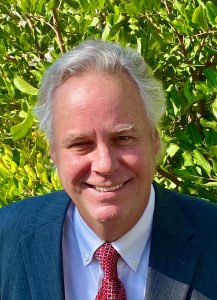
Flanigan’s Net Positive: China’s Renewable Revolution in Perspective
This is amazing news. Sure there’s more to be done, but let’s relish in the goods. China may reach its aggressive renewable energy target five years early. It’s a country that the Washington Post noted is, “light years ahead of the U.S. in building clean power.” Among other renewable energy breakthroughs, in 2022, China finished the Baihetan hydroelectric power project, the country’s second largest hydropower station.

China is not only powering an ever-increasing slice of its own economy with renewables – largely solar and wind – but it is providing products like solar panels all over the world. As has been reported in EcoNet, China is the world’s factory. Chinese-made PV modules, wind turbines, gear boxes, and other key components made up for 70% of the global market share last year.
Global Energy Monitor is a San Francisco-based non-profit NGO which catalogs fossil fuel and renewable energy projects worldwide. Its Global Solar and Wind Power Trackers identify prospective projects that have been announced or are in the pre-construction and construction phases. According to its data released in June, China is on course to hit its 2030 target of 1,200 GW of renewable energy capacity five years early.
That’s impressive! Time to increase the goal, to raise the bar? Absolutely. Martin Weil at Global Energy Monitor makes clear that baseload coal is, “still holding sway as the dominant power source.” Others take it a step further, suggesting that the boom in renewables is sadly going hand in hand with a boom in coal-fired power plants. Every one of the coal plants that made up 40 GW of capacity that was given the go-ahead last year was in China. The world consumption of coal would have peaked in 2018 if not for China’s continued development of coal plants. This has added 862 million tons of annual coal production and consumption. A massive project in Mongolia features 16 GW of solar, 4 GW of wind, and as an odd partner… 4 GW of coal.
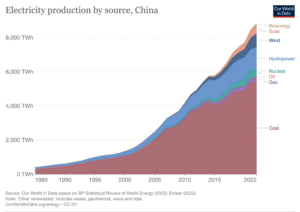
Image Courtesy of Our World in Data
Let’s get back and put China’s renewables in perspective. According to the Bureau of National Statistics, and when considering all power sources, in 2021 China had 2,380 GW of installed electrical capacity. By the end of 2022, the capacity had grown to 2,564 GW. (That compares to 1,160 GW in the U.S.) China is forecasted to have 3,000 GW of demand by 2025.
Currently China has 757 GW of operating wind and solar, already 30% of the nameplate capacity. Watch this space! In addition to the existing 757 GW, there is 750 GW of prospective wind and solar, the majority of which is expected to come on line by 2025. That is made up of 379 GW of utility-scale solar and 371 GW of wind capacity.
If all prospective projects are built and commissioned as planned, it will equate to a doubling of China’s utility-scale solar and wind power capacity. China is spending $250 billion a year on renewables, as much as the rest of the world combined. It is installing nearly half of the world’s new renewable energy capacity.

The numbers are impressive: China’s operating utility-scale solar capacity is 228 GW, more than the rest of the world combined. The world’s leading solar panel manufacturer, the Chinese company Jinko, is producing 30 GW of panels a year. That’s not a typo; nor is it off by an order. China’s wind capacity has doubled since 2017 and now stands at 310 GW. Of this, offshore wind is about 10%, or 31.4 GW. That’s more than all the offshore wind capacity in Europe where there is 22.07 GW of capacity made up of 5,047 turbines in 12 countries.
So hats off to China for being a leader in renewables. Its next step is to seize the opportunity now to fully green its power sector sans coal.
Quote of the Month
“This new data provides unrivaled granularity about China’s jaw-dropping surge in solar and wind capacity. As we closely monitor the implementation of prospective projects, this detailed information becomes indispensable in navigating the country’s energy landscape.”
U.S. EV Charging Networks

The Electric Vehicle Charging Stations and U.S. Interstates map, developed by Esri
The U.S. Department of Energy’s Alternative Fuels Data Center tracks access to alternative fuels, such as electricity and compressed natural gas. It finds that there are ~50,000 public EV charging stations in the country. That compares with ~150,000 conventional gas stations. Like gas stations with multiple pumps, each EV charging station has multiple “Electric Vehicle Supply Equipment” (EVSE) ports. The 50,000 stations in America have 130,000 EVSE ports.
Which is the biggest EV charging network? Chargepoint is the answer. It has 27,000 stations and 50,000 charge ports. Number 2? That’s Tesla with 6,000 stations and 28,000 charge ports. Tesla is the leader of fast-charging stations, the Level 3 variety. Most Chargepoint stations are Level 2.
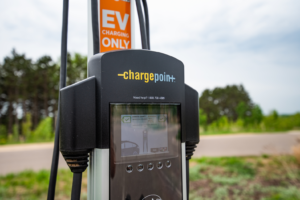
The speed of charging is a big differentiator. While home or hotel use allows the use of Level 2 overnight charging or topping off, along highways it’s different: Charging speed is essential. Of the 50,000 U.S. charging stations, 44,000 are Level 2 stations with over 100,000 charging ports. Recent data shows 6,600 DC fast charging stations with 28,000 charging ports.
Tesla is the only auto brand that owns and operates its own proprietary charging network. Its superchargers max out at 250 kW, equating to 200 miles of range in 15 minutes. Tesla has 1,600 Supercharger stations in the U.S. with 17,000 fast charging ports. Next in line is Electrify America with 800 stations and 3,600 fast charging ports. EVgo has 2,200 fast charging ports; ChargePoint has 1,800.
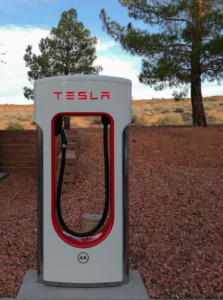
Another key parameter is price. How much does the power cost to fill your EV? The other day in San Diego, the Tesla Supercharger price was 32 cents per kilowatt-hour on a Sunday afternoon. Users access ChargePoint chargers using the ChargePoint app. Some cities have offered charging for free, some to the public, some limited to employees. Other chargers take credit cards. Others can only be accessed via membership with a credit card on file.
Electrify America is owned by Volkswagen Group of America. It has a partnership with Ford. Every Mache buyer gets 250 kWh of fast charging on its network. VW was required to build out that network as part of its settlement with the government related to its diesel emissions scandal. Its chargers can charge up to 350 kW. Electrify has a comprehensive network. It boasts that its users can take their EVs coast to coast using its charging in its network, allowing for a non-Tesla, EV road trip!
Greenlots is a charging network that is based in Los Angeles. It is owned by Shell and plans to convert Shell gas stations to EV charging stations. GreenLots is being rebranded as Shell Recharge. Francis Energy is a supercharger network from Oklahoma.
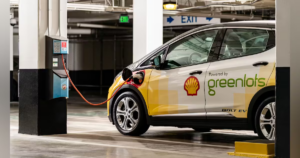
Image Courtesy of Greenlots
There is no question that an underpinning of the transition to EVs is fast charging, allowing for quick and easy “refueling” … especially on road trips. Fast charging is the only practical level of charging for long distance travel. But fast chargers are a fraction – less than 20% – of the total number of EV chargers nationwide, and 60% of them are in the Tesla network.
The federal government is now squarely behind charging: It is investing $5 billion to launch a national EV charging network. Last September, the DOT approved plans from all 50 states to build a nationwide network of EV chargers. The National Electric Vehicle Infrastructure (NEVI) formula program will provide funding for states to build out networks. Once complete, the highway charging network will cover 75,000 miles of highways across the country. NEVI will create, “a generation of good paying jobs, building a nationwide network of EV chargers,” noted Secretary of Transportation Buttigieg. These are big steps toward the goal of 500,000 public EV chargers by 2030.
Clean Energy Job Growth
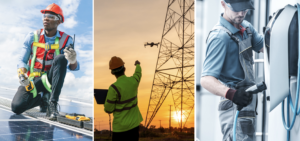
Image Courtesy of U.S. Department of Energy’s United States Energy & Employment Report 2023
The U.S. Department of Energy has released its 2023 U.S. Energy and Employment Report. Overall, almost 300,000 workers were added to the energy workforce in 2022, a 3.8% growth rate over the prior year. The data shows strong growth in clean energy jobs spurred by investments from the Infrastructure Investment and Jobs Act (IIJA) and the Inflation Reduction Act (IRA).
In 2022, there was growth in almost every state. Overall, clean energy jobs increased by 3.9%, adding 114,000 nationally, representing over 40% of total energy jobs. Solar and wind accounted for more than 84% of the net new electric power generation jobs, adding 21,000 jobs, a 3.6% growth. States with the greatest clean energy job growth were California which added 13,000 jobs (3.2%), West Virginia which added 7,000 jobs (19%), and Texas which added 5,100 jobs (3.5%). Jobs related to EVs were up 21%, adding 38,000 jobs.
The USEER report began in 2016 to track employment within key energy sectors: electricity production and generation; transmission distribution, and storage; energy efficiency; and motor vehicles and component parts.
In related news, McKinsey’s “Graphics of the Week” highlights that wind, solar, and storage growth has almost tripled with the passage of the Inflation Reduction Act. Before the IRA, the growth rate was 6% per annum; after the IRA it was 16%. The McKinsey proclamation is in line with the Lawrence Berkeley National Laboratory (LBNL) portrayal of the national utility interconnection queue.
Volkswagen Group France Commissions 20 MW of Solar

Image Courtesy of Engie
The Volkswagen Group (VW) is about to commission another major solar installation, this time at its facility in Villers-Cotterets, France, in the northern Haut-de-France region. The 20 MW solar installation has been constructed and financed by Engie. Two 10 MW arrays cover a 37-acre park lot. A VW representative noted that the solar-covered “carpark” is fully in line with the German company’s GotoZeroStrategy to reduce its carbon footprint.
Engie Green, the renewable energy unit of the French energy group Engie, developed the $21.8 million solar system. Engie will own and maintain the facility for 32 years. The project was supported by the French Ministry of Ecological Transition through a tender process in 2020 and 2021. The project also got support from crowd funding from local communities.
VW’s goal is to be 100% renewably powered by 2023. In 2020, the VW Group increased its use of renewables from 80% to 95% when ten of its factories became 100% powered with renewables. Eight sites are in the EU; two outside the EU. The largest sites were the Audi plants in Hungary and Germany, and the VW plant in Portugal. All told, the sites are located in seven countries.
Note that these values are based on offsetting the “external supply” the power that VW buys from the grid. When factoring in process heat and cogeneration on site, renewables accounted for 46% of the company’s energy needs in 2020. VW has its own power plants that base its carbon footprint and are also in focus for carbon reduction. Its coal-fired units at its Wolfsburg plant will be converted to natural gas, reducing CO2 emissions there by 60%.
The Most Efficient Cars
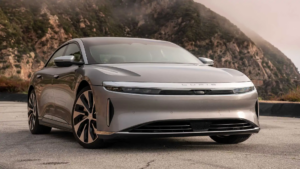
The highest U.S. Environmental Protection Agency-rated cars in model year 2023 are now public. For gasoline vehicles, the highest fuel economy was 60 miles per gallon, mpg. For EVs, the Hyundai Ioniq 6 and the Lucid Air achieved 140 mpg equivalent. Not far behind are the Chevy Bolt (120), and BMW i4 (113).
EPA uses 33.7 kWh per gallon of gasoline to compute the comparative mpg rating for EVs. This is based on 115,000 BTUs per gallon of gasoline, and an industry standard efficiency of a conventional thermal power power plant of 3,412 BTUs/kWh. As less conventional power plants exist, EPA may change its “industry-standard” measure. EV mpg may well increase as a lesser BTU value is used in the future per kWh.
From Model year 2011, 12 years ago, the maximum fuel economy of gasoline-powered cars has increased by 19% while EV efficiency has grown 37%. All based on EPA’s combined city/highway fuel economy rating. At the other end of the spectrum, EPA’s survey revealed 17 vehicles sold in the U.S. that get less than 17 miles per gallon. These come from brands including Bugatti, Bentley, Mercedes, Rolls-Royce, Lamborghini, Cadillac, and Dodge.
Wind Updates
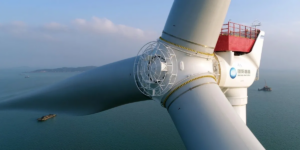
Image Courtesy of MingYang Smart Energy
16 MW Turbines: Just months ago EcoNet reported on record-sized wind turbines. Now the first 16 MW turbine has been installed and is in offshore operation in China. These massive turbines are being built, owned, and operated by China Three Gorges (CTG) and Goldwind, part of CTG’s Zhangpu Liuoa offshore wind farm. Goldwind’s GWH252 has 404-foot long blades, a rotor diameter of 830 feet, and a swept area of 538,195 square feet. Each spin of the turbine results in 34.2 kWh of power.
Vertical Axis Turbines: Swedish wind turbine maker – SeaTwirl – reports that it has received its first order for its novel vertical axis turbines. They will be deployed in the North Sea. The agreement signed with early phase offshore wind developer Kontiki Winds, is for SeaTwirl’s S1 model.
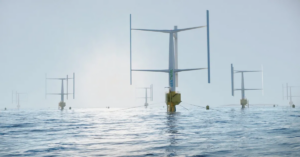
Image Courtesy of SeaTwirl
The S1 is a 30 kW floating turbine designed to withstand the demanding conditions in the North Sea. SeaTwirl is configured 43 feet above sea level and 59 feet below. S1s can be placed in dense packs for increased output. Offshore wind turbines are generally limited to be tethered and anchored in maximum depths of 200 feet. SeaTwirld’s turbines can be anchored in much deeper waters.
Global Installed Wind Capacity: There is now 1 terawatt, or 1,000 gigawatts or 1 million megawatts, or one billion kilowatts… of wind capacity globally. According to the Global Wind Energy Council (GWEC), “it took 40 years to get here.” That timeframe began when Danish engineers began to experiment with the designs that now serve as the foundation of the current wind industry. GWEC chairman, Jonathan Cole warns that, “ While this is an immense achievement, it still represents only a small portion of what must be built in the coming years in order to decarbonize our planet.” While it took 40 years to achieve the first terawatt, GWEC forecasts another 2 TW in the next seven years.

Solar O&M for Aging Systems

EcoMotion is pleased to welcome Simon Caplan as an intern at EcoMotion. He is finishing up his final year at Columbia University where he is a Kluge Scholar and a Sustainable Development major.
For EcoMotion, Simon has done research on Operations and Maintenance (O&M) providers for aging solar systems. Where can solar system owners like school districts turn for help? The research focus was on commercial customers… with Southern California the primary target for listing of providers. That said, several listed in the spreadsheet of providers are national.
EcoMotion is in the business of providing solar consulting services. Recently, we’ve been involved in performance monitoring and repair of aging systems. Click here to download Simon’s research summary and/or his spreadsheet of Solar O&M Providers.
Flanigan’s Ego-Logic Podcast Updates
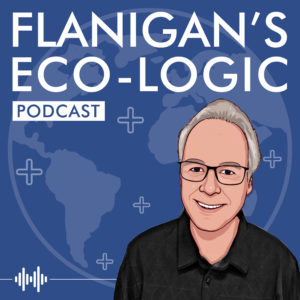
Use the links below to check out our recent podcasts. And you can always go to Spotify and type in “Ted Flanigan” to find our library of podcasts.
Recently Released:
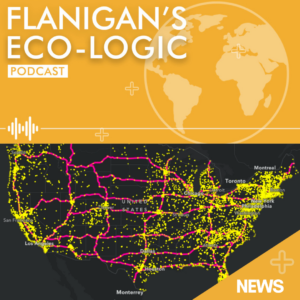
In EcoNet News, Volume 25, Issue #7, Ted puts China’s renewable revolution in perspective. He also highlights the U.S. EV charging networks, celebrates clean energy job growth, and shares some renewable energy news from around the world. There are stories on the Volkswagen Group commissioning a major solar installation in France, the EPA’s rating of most efficient cars in 2023, and wind updates out of China and Sweden, as well as global wind capacity breaking record – 1 terawatt, or 1,000 gigawatts, or 1 million megawatts, or one billion kilowatt of wind capacity globally!

In this episode of Flanigan’s Eco-Logic, Ted speaks with Janice Lin, Founder and Chief Executive Officer of Strategen, a mission driven consulting firm that specializes in accelerating the clean energy transition.
Janice has distinguished herself as a leading clean energy changemaker and visionary. She brings more than two decades of experience in clean energy market development and corporate strategy to her current role. At Strategen she has advised a diverse range of clients including renewable energy technology and service providers, developers, large corporations diversifying into clean energy, utilities, investment funds, and non-governmental organizations such as the World Bank.
In 2019 Janice founded and serves as President at the Green Hydrogen Coalition, an educational non-profit dedicated to advancing the production and use of green hydrogen in all sectors where it will accelerate the transition to a carbon free energy system.

In this episode of Flanigan’s Eco-Logic, Ted speaks with Ari Matusiak, Founder and Chief Executive Officer of Rewiring America, the leading electrification non-profit, focused on electrifying everything in our communities. Ari is also the Co-Founder and Managing Partner of Purpose Venture Group, a social impact incubator building ventures to address climate and economic inequality.
In his current role, Rewiring America is working to launch a movement that electrifies everything. His team is motivated by the fact that 90 percent of all emissions in the U.S. are energy-related, and 42 percent of those energy emissions come from the decisions made at around kitchen tables: how we heat our air and water, cook our food, and dry our clothes, and what kind of cars we drive. Through accurate, accessible, and actionable data and storytelling tools that power smart, inclusive advocacy and market-transforming partnerships, Rewiring America aims to achieve national emissions goals, improve health, lower monthly bills, and create millions of clean energy jobs.
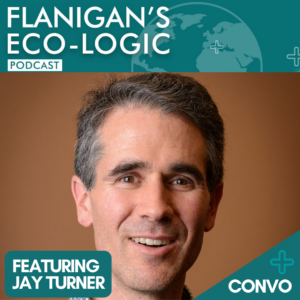
In this episode of Flanigan’s Eco-Logic, Ted speaks with Jay Turner, Professor of Environmental Studies at Wellesley College and Author of Charged: A History of Batteries and Lessons for a Clean Energy Future.
Jay is also Author of The Promise of Wilderness: American Environmental Politics since 1964 (2012), which focuses on debates over public lands protection in the United States. His second book, The Republican Reversal: Conservatives and the Environment from Nixon to Trump (2018, co-authored) details the evolution of conservative opposition to environmental reform, culminating with the Trump administration.
His most recent book, Charged: A History of Batteries and Lessons for a Clean Energy Future, unpacks the history of batteries to explore why solving the battery problem is crucial to a clean energy transition. He highlights their many uses: powering zero-emission vehicles, storing electricity from solar panels and wind turbines, and modernizing the electric grid, and demonstrates that they are essential to scaling up the renewable energy resources that help address global warming. He also digs into batteries’ unique environmental impact—including mining, disposal, and more—questioning a clean energy transition risk trading one set of problems for another. With new insight on questions of justice and sustainability, Charged draws on the past for crucial lessons that will help us build a clean energy future, from the ground up.

In this episode of Flanigan’s Eco-Logic, father-daughter duo, Ted and Sierra Flanigan host the clean energy crash course focusing on the power grid and its stresses as things start to heat up across the country this summer. They discuss “the electricity traffic jam” and the importance of raising awareness of peak conditions.
They start by bringing the power grid down to basics – power plants, transmission lines, distribution lines – and how the grid handles this kind of stress. The conversation uses California and its Independent System Operator which manages our 50 GW system. Ted and Sierra then shift to responsible actions that each of us can take on the demand side to alleviate peak demands that are costly, and at times are highly disruptive and sometimes even life threatening.
Ted breaks what he calls “smart energy management” into four actions: conservation, energy efficiency, load management, and local distributed solar energy. Sierra asks Ted to link these actions with grid duress. What can be done right away? Ted encourages incremental action on the homefront, we can all cut our power use by at least 5%, and encourages listeners to back policies that support innovation and an accelerated path to the ubiquitous clean energy future.
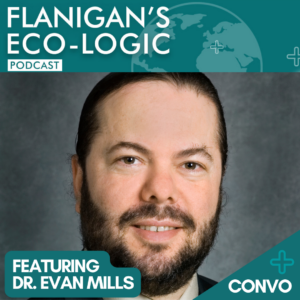
In this episode of Flanigan’s Eco-Logic, Ted speaks with Dr. Evan Mills, a recently retired Senior Scientist at the U.S. Department of Energy’s Lawrence Berkeley National Laboratory (LBNL), operated by the University of California–one of the world’s leading research centers on energy and environment. He was past leader of LBNL’s Center for Building Science, which represented the work of about 400 people, and continues his collaborations with “The Lab” as an Affiliate. He is also a Research Affiliate at the Energy Resources Group, operated by the University of California.
Dr. Mills is a member of the international body of scientists under the auspices of the Intergovernmental Panel on Climate Change (IPCC). The IPCC collectively shared the Nobel Peace Prize for 2007 with former U.S. Vice President Albert Arnold (Al) Gore Jr. His research centers on the impacts of climate change and mitigating those impacts through reduced emissions and loss prevention. His specialties are energy efficiency in buildings and industry and the intersection of energy technology, global climate, and risk management.
His interests further center around pinpointing “sleeper” uses of energy and empowering policymakers, consumers, and non-traditional market actors to capture improved efficiencies, reduced greenhouse-gas emissions, resilience, and other non-energy benefits. Specifically, he highlights the edge cases and topics that don’t get attention from mainstream policies, programs, or research agendas like the problem of kerosene lighting in the developing world, the issue of housing insurance in the face of climate change, green-gaming, the carbon footprint of cannabis cultivation, and remaining optimistic about the areas of improvement in building commissioning.
